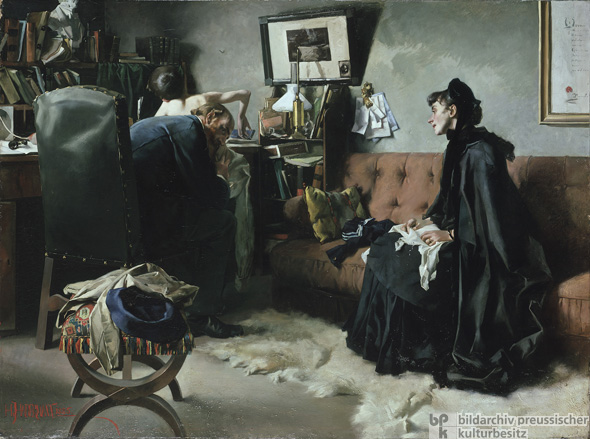|
Baron Hugo von Habermann, A Delicate Child [Ein Sorgenkind] (1886)
This study of a visit to a doctor’s office was painted in a naturalist style by Baron Hugo von Habermann (1849-1929). The son of a cavalry officer, Habermann was born in Dillingen on the Danube and moved to Munich as a school-boy. He attended Gymnasium (high school) there and went on to study law at the city’s university. All the while, he also studied painting and drawing, his real passion. After taking part in the Franco-Prussian War, Habermann was based in Ingolstadt, where he was assigned to mentor artists who were drawing sketches of French prisoners of war. It was at this point that Habermann decided to give up his legal studies and fully devote himself to painting. Returning to Munich, he was admitted to the Academy of Fine Arts in November 1871; he joined the Munich Art Cooperative in 1878. Not long thereafter, in 1880, he opened a private painting academy with Bruno Piglheim and Fritz von Uhde. For the first half of the decade, however, Habermann remained little known. Then, in 1886, this painting suddenly came to the attention of art critics and the public. A Delicate Child won a gold medal that year in an exhibition in Munich’s Glass Palace. For some critics, the painting was not “attractive” enough. But preliminary sketches indicate how carefully Habermann composed the work. (A Signora di Torri, whose portrait the artist painted the same year, was the model for the worried mother.) After 1886, Habermann retreated into relative obscurity, both professionally and personally. His art moved between Jugendstil studies of Dionysian scenes and portraits of wealthy society women; he suffered from ill health; and late in life he emerged from his house only rarely. This lonely existence was eventually made more bearable by the fact that Prince Regent Luitpold of Bavaria awarded him the title Professor for his portrait Salome (1897), which was shown that year at the International Art Exhibition in Munich. The portrait went on to become known as Habermann’s greatest work.

|


